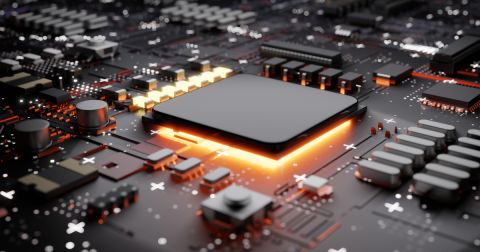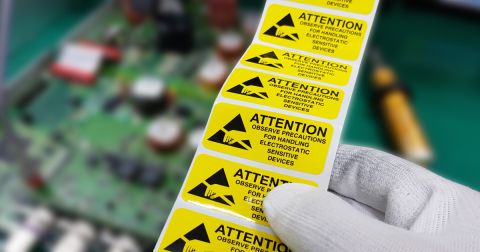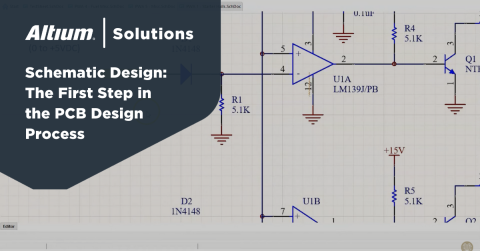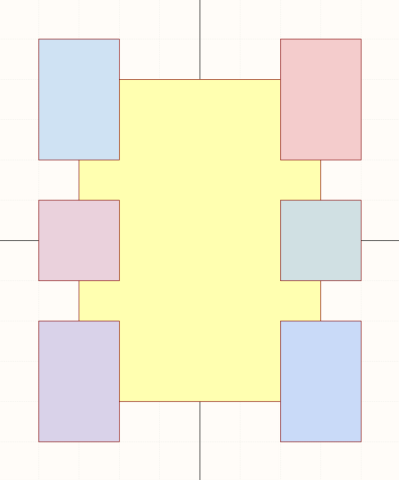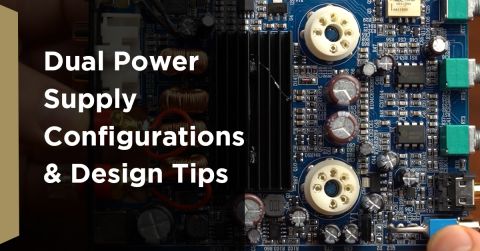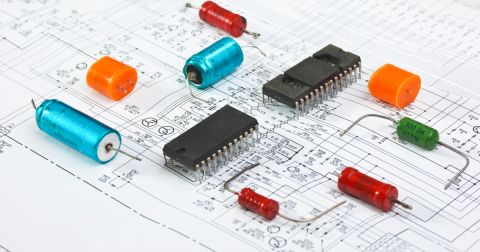Which Capacitor Types Should You Use?

Capacitors are one of the main components in all electronic devices and are vital to their operation. In modern electronics, you will most commonly find ceramic capacitors decoupling power supplies for almost every integrated circuit (IC) on a circuit board or aluminum electrolytic capacitors as bulk capacitance for a voltage regulator. However, capacitors are used in far more applications than just bypassing noise, and there are many more types of capacitors than only ceramic analog suppliers and aluminum electrolytic.
Different types of capacitors are used for:
- Coupling
- Decoupling
- Filters
- Energy storage/supply
- Impedance matching
- Snubbers
- and many more applications
In this article, we’re going to look at all the different types of capacitors, where they might be used, and common capacitor voltages. While we might think of capacitors as being a stable technology that hasn’t changed in decades, the reality is that capacitor today is very different from just a decade ago, never mind 20 years in the past. Applications you would never imagine using a certain type of capacitor for in the past are perfectly reasonable today with the advances in capacitor technology. In contrast, while some capacitors today might be thought of as obsolete with no practical applications compared to other capacitor types, they still have their niche applications at which they excel at.
Although all the different types of capacitors provide capacitance - they are not all equal. Capacitance is not the only critical parameter when selecting a capacitor, and each type of capacitor is used in different applications, so sometimes making the right choice is not an easy task. It would be best if you considered capacitance, maximum voltage, equivalent series resistance (ESR), equivalent series inductance (ESL), longevity, size, price, availability, parameters that change with temperature, and so on. For example, when choosing a bypass capacitor, the ESR and ESL parameters are essential. On the other hand, when choosing a capacitor for energy storage or sudden load change, current leakage can be more critical.

Choosing your capacitor primarily depends on your application and budget constraints. The price of capacitors can vary, from less than a cent to more than $100.
Let’s take a look at the capacitor types, where they are used, and when one is more suitable than another.
Ceramic Capacitors
Ceramic capacitors are one of the most popular and common types of capacitors. In the early days, ceramic capacitors had very low capacitance, but nowadays, this is not the case. Multilayer ceramic capacitors (MLCC) are used extensively in circuits; their capacitance rating can reach hundreds of microfarads (µF). Modern ceramic capacitors can be used in place of other capacitor types for dated hardware/designs, such as electrolytic or tantalum. The difference between an electrolytic capacitor and a ceramic capacitor is the latter offers higher performance at a lower cost.

Image Source
MLCCs have a ceramic dielectric body, which is a mixture of finely ground granules of para-electric or ferroelectric materials and other components to achieve the desired parameters. They have multiple layers of electrodes which create the capacitance. The ceramic is sintered at high temperatures to form the electrical and mechanical basis of the capacitor.
The ceramic layers are usually very thin; however, this depends on the voltage rating of the component. The higher the voltage, the greater the thickness and size of the capacitor for the same capacitance. The capacitor is usually protected from moisture and other contaminants by a thin coating.
Although there are through-hole/leaded versions of ceramic capacitors as there always have been, it is the surface-mount type that truly shines. Interestingly, if you break apart many through-hole ceramic capacitors today, you might find a surface mount capacitor attached to leads under the bead! The volume of production and economies of scale that volume provides for surface mount capacitors makes it cheaper for manufacturers to simply re-package a surface mount component into a through-hole package. Surface mount ceramic capacitors can offer highly competitive capacitance ratings for their tiny size. MLCCs are the smallest capacitors on the market, with packages down to 08004 (0201 metrics). Without these tiny capacitor sizes, high-performance, high-density boards would not be viable.
MLCCs are not only popular because they are compact with relatively high capacitance, but also because they are critical for many applications where the electrolytic type would be completely unsuitable. As an often overlooked advantage, ceramic capacitors generally will not burst into flames or explode if you don’t treat them right. They do not have a polarity and can have voltages significantly beyond their ratings applied to them with no damage to the capacitor itself. In contrast, aluminum electrolytic and especially tantalum vs. ceramic capacitor have a tendency to turn into little rocket motors or explode if even a minor reverse voltage is applied to them, or their ratings are even slightly exceeded.
Other advantages of this type of capacitor:
- Wide capacitance and voltage range
- Highly reliable performance
- Tape & reel for surface mount assembly
- Low ESR
- High Q at high frequencies

Image Source
Despite their general advantages and benefits, not all ceramic capacitors are equal, some are extremely cheap, while others are costly. The parameters of the capacitor also depend on several factors, such as which ceramic dielectric type is used. The most commonly stocked dielectric types are C0G, NP0, X7R, Y5V, and Z5U.
There are two main classes of ceramic type of capacitors:
Class 1: offers high stability and low losses for resonant circuit applications (NP0, P100, N33, N75, etc.).
Class 2: offers high volumetric efficiency for buffer, bypass, and coupling applications (X7R, X5R, Y5V, Z5U, etc.).
Class 1 Ceramic Capacitors
Class 1 ceramic capacitors offer the highest stability and lowest losses. They have high tolerance and accuracy and are more stable with changes in voltage and temperature. Class 1 capacitors are suitable for use as oscillators, filters, and demanding audio applications.
The tolerance codes for class 1 ceramic capacitors are given below:
| First Character | Second Character | Third Character | |||
|---|---|---|---|---|---|
| Letter | Sig. Figures | Digit | Multiplier (10x) | Letter | Tolerance |
| C | 0.0 | 0 | -1 | G | +/- 30 |
| B | 0.3 | 1 | -10 | H | +/- 60 |
| L | 0.8 | 2 | -100 | J | +/- 120 |
| A | 0.9 | 3 | -1000 | K | +/- 250 |
| M | 1.0 | 4 | +1 | L | +/- 500 |
| P | 1.5 | 6 | +10 | M | +/- 1000 |
| R | 2.2 | 7 | +100 | N | +/- 2500 |
| S | 3.3 | 8 | +1000 | ||
| T | 4.7 | ||||
| V | 5.6 | ||||
| U | 7.5 | ||||
The first character is a letter that indicates the significant figure of the change in capacitance over the temperature in ppm/°C. The second character is numeric and denotes the multiplier for the first character. The third character is a letter that represents the maximum error in ppm//°C.
For example: C0G ceramics offer one of the most stable capacitor dielectrics available. Capacitance change with temperature is 0 +/- 30ppm/°C, which is less than +/- 0.3% of the rated capacitance from -55°C to +125°C. The capacitance drift or hysteresis for C0G ceramics is negligible at less than ±0.05% versus up to ±2% for film capacitors.
The C0G (NP0) ceramic dielectric usually has a “Q” in excess of 1000 and shows little capacitance or “Q” changes with frequency. In addition to this, the dielectric absorption is typically less than 0.6%; this is similar to mica which is renowned for having very low absorption. This makes ceramic capacitors excellent for RF applications, and you can typically find ceramic capacitors which are specifically designed for RF circuits.
Class 2 Ceramic Capacitors
Class 2 ceramic capacitors have a much higher level of permittivity than those in class 1. This gives them a much higher capacitance level per unit of volume. However, as the tradeoff for this higher density, they have lower overall accuracy and stability. In addition to the lower precision and stability, class 2 ceramic capacitors also exhibit a non-linear temperature coefficient and a capacitance that is dependent, to a small degree, on the applied voltage.
Such capacitors are ideally suited to decoupling and coupling applications where the exact capacitance value is not critical, but where space may be an issue. They are also ideal for bulk capacitance on circuits that have rapidly varying loads, yet need to have a compact footprint, such as RF transmitter/transceiver ICs.
The character codes for class 2 ceramic capacitors tolerances are:
| First Character | Second Character | Third Character | |||
|---|---|---|---|---|---|
| Letter | Low Temp | Digit | High Temp | Letter | Change |
| X | -55°C (-67°F) | 2 | +45°C (+113°F) | D | +/- 3.3% |
| Y | -30°C (-22°F) | 4 | +65°C (+149°F) | E | +/- 4.7% |
| Z | +10°C (+50°F) | 5 | +85°C (+185°F) | F | +/- 7.5% |
| 6 | +105°C (+221°F) | P | +/- 10% | ||
| 7 | +125°C (257°F) | R | +/- 15% | ||
| S | +/- 22% | ||||
| T | +22% / -33% | ||||
| U | +22% / -56% | ||||
| V | +22% / -82% | ||||
The first character is a letter that represents the low end of the operating temperature range. The second is the number and indicates the upper limit of operating temperature. The third character is a letter that denotes the capacitance change over the full operating temperature range.
One of the most common and popular classes 2 ceramic dielectrics is X7R which has a temperature range of −55°C to +125°C and a capacitance change of ±15% which is a relatively low cost yet still has relatively good tolerance. Y5V capacitors are also very common as the capacitance or voltage starts to reach the upper end of a given package. It has a temperature range of −30 to +85°C and tolerance across the range of +22/−82%, which is still suitable for many decoupling or bulk capacitance requirements that need to be compact and cost-effective.
Class 3 Ceramic Capacitors
Historically, there are also class 3 ceramic capacitors that offer high capacitance per unit of volume. These dielectrics are challenging to find still in production as modern class 2 multilayer ceramics can offer similar or higher capacitances combined with better performance in a more compact package.
Tantalum Capacitors
Tantalum is a type of electrolytic capacitor that is made using tantalum metal as the anode, covered by a thin layer of oxide that acts as the dielectric. Tantalum offers a very thin dielectric layer which results in higher capacitance values per unit volume.

Image Source
Tantalum capacitors are polarized, which means they are only able to be used with a DC supply and only placed in the correct orientation. A tantalum capacitor used outside of its rated voltage/temperature or with the incorrect polarity will rapidly lead to thermal runaway, causing fires and even small explosions. These can be mitigated by using safety components, such as current limiters or thermal fuses in your design. Still, it is something to be aware of when using tantalum capacitors near their ratings.
In comparison to ceramic capacitors, the equivalent series resistance of a tantalum capacitor is relatively high, typically orders of magnitude higher. This makes tantalum capacitors a poor choice for high-frequency applications.
Tantalum capacitors are typically significantly higher priced than MLCCs, so the usage of tantalum caps has become increasingly rare for general applications. They do have some outstanding features which make them ideal for certain applications, despite their additional cost.
Linear Capacitance Change with Temperature
Tantalum capacitors exhibit a linear capacitance change with temperature. This linear change makes it easier to calculate the capacitance under critical conditions. In addition to the linear change, the capacitance of tantalum capacitors rises with temperature, which offers advantages for energy storage or for switched-mode power supply load changing stability, for example. If a tantalum capacitor is close to a switched-mode power supply, its capacitance will rise slightly as the power supply comes under heavy load and heats up.

Image Source
Limited Microphonic/Piezoelectric Effects
Due to the piezoelectric effect, ceramic types of capacitors are microphonic as they vibrate, generating voltages like a piezo microphone. This effect can cause additional noise in a circuit which is not ideal for boards in high-vibration environments with sensitive/low-voltage analog signals. This noise is not significant enough to affect digital or amplified analog signals, however unamplified analog signals from transducers or other very sensitive signals could be affected. This is one reason many audio-related components do not recommend ceramic capacitors. Tantalum capacitors do not tend to have piezoelectric/microphonic characteristics, which makes them ideal for audio applications, or applications that experience high vibration.

Image Source
Capacitance vs Voltage Characteristics
Tantalum capacitors are very stable under different DC voltage conditions, as long as those conditions do not extend beyond the capacitor’s ratings. The capacitance of multilayer ceramic capacitors changes significantly with voltage, decreasing in capacitance as the voltage increases. This can be vital for applications with varied voltages, and may also make a tantalum capacitor comparable in price to an MLCC in certain applications. A tantalum capacitor will typically give you the full capacitance that is advertised, less any tolerance. For low noise power supplies and critical decoupling applications where a ceramic capacitor might be operating close to its maximum voltage, you will require 1/3rd of the capacitance from a tantalum capacitor as from a ceramic capacitor. Alternatively, you will need 1/3rd of the number of parallel capacitors to have the same real-world capacitance, which could offer significant space savings.

Image Source
Stability Over Time
The permittivity of the dielectric in ceramic capacitors is due to the degradation over time of the polarised domains in ferroelectric dielectrics. While this might sound like a line of technobabble from a science fiction show, the real-world effect is a decreasing capacitance over time. Tantalum capacitors, on the other hand, tend to remain stable over their lifetime. Tantalum capacitors also do not dry out or degrade like aluminum electrolytic capacitors which makes tantalum capacitors ideal for long-life service applications, especially in scenarios where servicing is expensive or impossible, or where a device is mission-critical.

Image Source
Aluminum Electrolytic Capacitors
The aluminum electrolytic types of capacitors are iconic. If you search for images of capacitors you’re likely to get a picture of an aluminum electrolytic capacitor. In modern electronics, aluminum capacitors are mostly relegated to bulk capacitance applications where a significant amount of capacitance is required due to their bulk, high ESR, and current leakage. Although they have been replaced in many applications, they are still very popular because of their vast capacitance values, high maximum voltage ratings, and low cost.

Image Source
An aluminum electrolytic capacitor is constructed with a liquid electrolyte. The electrolyte is a liquid or gel that contains a high concentration of ions. As with tantalum capacitors, which are also electrolytic, aluminum electrolytic capacitors are polarized. This means the positive terminal must have a higher potential than the negative terminal. Unlike in science fiction shows where the captain calls “reverse the polarity” to make something work, if you do that with an aluminum capacitor it will rapidly fail, bursting and potentially catching fire.

Image Source
Aluminum capacitors in many applications have been replaced by lower-cost multilayer ceramic capacitors, low ESR aluminum polymer capacitors, or tantalum capacitors due to the high number of drawbacks with aluminum electrolytic capacitors. Aluminum types of capacitors have very high equivalent series resistance, which causes them to dissipate a lot of power when signals that have a high frequency or large amplitude are applied to the capacitor. The lifetime of an aluminum capacitor is severely limited by the electrolyte, which can dry out - the lifetime is greatly reduced with high service temperatures. The leakage current of an aluminum capacitor is substantially higher than most other capacitor types which makes them less than ideal for coupling applications.
The drawbacks make these capacitors unusable in many modern applications. However, aluminum capacitors are not going anywhere as they have several redeeming features, not least of which is their meager cost for comparable capacitance/voltage. Aluminum capacitors also offer capacitance values up to several farads, and much higher voltages than many other types of capacitors, at least when capacitance is taken into account. Despite their bulk, they can have a smaller footprint than the equivalent capacitance in multiple other capacitors of a different type in parallel as it’s typical for aluminum capacitors to have a high aspect ratio of diameter to height. If vertical clearance isn’t an issue, an aluminum capacitor can have exceptional capacitance for its footprint.
In comparison to tantalum capacitors, aluminum capacitors tend to do less damage to a circuit when they fail. As an aluminum capacitor comes towards the end of its life, it tends to reduce capacitance gradually. If it fails due to overvoltage or other abuse, it will typically burst or swell without taking out a chunk of your circuit board in the process, or causing a fire.
While polymer versions of aluminum capacitors offer many advantages, the simple aluminum capacitor is significantly cheaper and also provides higher maximum voltage ratings.
Aluminum electrolytic capacitors may be replaced in many applications because they do not meet the demanding requirements of modern circuitry, they are still unbeatable in applications where large capacitance values are required on a budget. They are used in many switching power supplies to reduce voltage ripple, audio or other low pass filters, smoothing, or bulk capacitance applications. While they may not be an ideal choice, sometimes they are the only choice or the only way to achieve a stable circuit within budget.
Polymer Capacitors
Polymer capacitors are a relatively new technology and rapidly becoming a prevalent type of electrolytic capacitor. They are an excellent alternative to basic aluminum and tantalum capacitors, and in some applications, even multilayer ceramic capacitors. These capacitors use conductive solid polymers as electrolyte rather than liquid or gel electrolytes that are found in traditional electrolytic capacitors. With both aluminum polymer and tantalum polymer capacitors offered in the same packages as their liquid electrolyte parents, it’s easy to upgrade an existing design to polymer capacitors and reap the benefits.

Image Source
By using solid electrolytes, polymer capacitors avoid the issue of liquid electrolyte drying out, which severely limits the life of classical electrolytic capacitors.
Polymer types of capacitors can be used as a replacement for tantalum electrolytic capacitors in most situations as long as they do not exceed the maximum rated voltage, which tends to be lower than that of classical electrolytic capacitors. Polymer capacitors are most commonly found with a rated voltage of up to 35V DC, but there are still plenty of options up to around 63V DC. There are a limited number of capacitors that are rated to go as high as 250V DC for aluminum polymer, or 125V DC for tantalum polymer.
The other reason why existing designs typically don’t replace most tantalum or aluminum electrolytic capacitors with polymer is that they are relatively expensive in comparison. That being said, there are several advantages to using polymer capacitors in designs, especially in power supplies. In several of my open-source project articles, I have specified aluminum polymer capacitors as their performance per dollar was unbeatable for those specific applications.
Capacitance vs Voltage Characteristics
Like the tantalum electrolytic capacitors we looked at earlier, polymer capacitors have virtually identical properties when it comes to capacitance vs voltage—the capacitance increases in a linear fashion as temperature increases.

Image Source
Very Low ESR
A significant downside of traditional tantalum and aluminum capacitors is their high equivalent series resistance. When used for filtering applications on a switched-mode power supply, it’s hard to obtain a shallow voltage ripple or mitigate conducted electromagnetic interference. The ESR of polymer capacitors is similar to many ceramic capacitors, which makes them ideal for filtering applications as they offer significantly higher capacitance values than ceramic options. While polymer capacitors are significantly higher priced than their liquid electrolyte counterparts, they are still far cheaper than an equivalent number of parallel ceramic capacitors. The low ESR of polymer capacitors makes them ideal for any high-current ripple applications where large amounts of capacitance are required.
High Capacitance Density
Aluminum polymer capacitors mainly offer very high capacitance density for their PCB footprint. Tantalum polymer capacitors don’t tend to come in the tall packages that aluminum capacitors do. The tall cylindrical aluminum capacitors allow you to provide exceptionally high capacitance by using high aspect ratio components, which are very tall relative to their footprint - if clearances allow.
No Leakage
Aluminum capacitors are known for their failure as the electrolyte either dries out or leaks. A leaking capacitor can destroy a circuit board that could otherwise be repaired by simply replacing the capacitor. Due to the solid polymer electrolyte, no leakage is possible.
No Piezoelectric Effect
Just like their non-polymer counterparts, as discussed earlier, the polymer variants do not have piezoelectric/microphonic issues, making them excellent for audio, and other sensitive ceramic analog suppliers' small-signal applications.
Frequency Stability
As touched on earlier, polymer capacitors are excellent for high-frequency applications in comparison to their liquid electrolyte counterparts. While not as good as a ceramic capacitor, they are very close and can offer high capacitance for a similar price and board footprint when compared to the ceramic capacitor option.

Image Source
This makes the polymer capacitors excellent for power supplies and audio applications. While a polymer capacitor is typically more expensive than other alternatives, it can offer cost savings over ceramic capacitors due to the reduction in capacitance at the voltage in ceramics - requiring fewer polymer capacitors to do the same job.
As an example, we take a simple DC-DC Buck power supply to serve as our PCB capacitor symbol in the diagram below:

Image Source
The application above requires 250 μF of capacitance at the input and 450 μF of capacitance at the output. Once the degradation of the ceramic capacitor’s capacitance over-voltage, aging, and temperature is considered, we are required to derate the ceramic capacitor by around 70%. This derating means that the capacitance should be around 833 μF at the input and 1500 μF at the output. It would require eighteen 47 μF ceramic capacitors on the input and fifteen 100 μF ceramic capacitors on the output. By using polymer capacitors, we could instead use two 150 μF polymer capacitors on the input and a single 470 μF polymer capacitor on the output. As the polymer capacitors do not need derating, they offer a 30% saving in cost and a 50% saving in the PCB area.
Film Capacitors
Film capacitors, as the name suggests, use thin plastic film as a dielectric. These types of capacitors are cheap, very stable over time, and have very low self-inductance and equivalent series resistance parameters. Some film capacitors can withstand extremely large reactive power surges.

Image Source
An extremely thin film is manufactured by a drawing process, which can then be metalized or left untreated depending on the properties required for the capacitor. Electrodes are then added, and the assembly is mounted into a case that protects the capacitor from the environment.
The relatively poor dielectric makes this type of capacitor very large in comparison to other capacitor types, giving it a very low capacitance per volume which lends it to significantly different applications to other options we have looked at. Film capacitors are used in many applications where stability, low inductance, and low cost are required.
One interesting aspect of metalized film capacitors is that they are self-healing. Self-healing occurs when defects cause external voltage transients. Any arcing within the capacitor vaporizes the thin metalization of the film around the failure. This causes the area that has failed to lose its metalized coating - without the conductive material there is no longer a short, so the capacitor ceases to be in a failure mode.
Polyester Film
Polyester film capacitors are general-purpose, low-cost film capacitors with the main advantage of excellent stability at higher temperatures (up to 125 °C). These are also known as the green capacitor type widely used in audio devices such as guitar amplifiers.
Key features:
- Leaded and surface mount packages
- Can work at 125°C with voltage de-rating
- High tolerance
- High dielectric strength makes for relatively small high-voltage capacitors
- Low ESR
- High dV/dt - can be used in applications where sharp, fast rise time spikes are present
They are typically used for:
- Circuits where the capacitor needs to handle high peak current levels.
- Filtering, where high tolerance levels are not required.
- General coupling and decoupling applications and DC blocking.
- Power supplies where the very high capacitance levels of electrolytic capacitors are not needed.
- Audio applications.

Image Source
Polypropylene (PP) Film
Polypropylene film capacitors are widely available and are useful in a wide range of applications.
Key features
- Extremely tight tolerance (up to 1%).
- Very stable as they incur very low changes in capacitance over time and voltage applied and their temperature coefficient is quite low, negative, and linear.
- Most PP capacitors have very low ESR and low self-inductance.
- PP capacitors can work with extreme voltages (u to 1kV).
- Fairly high-temperature ranges to 100°C or above.
- Only available as a leaded component.
- Available only for the very low range of capacitance (between 100pF and 10nF).
PP capacitors are used in many applications:
- High power/high AC voltage circuit applications.
- Circuits with high peak current levels.
- High-frequency resonant circuits.
- Precision timing circuits.
- Lighting ballast systems.
- Switching power supplies.
- Sample and hold circuits.
- Premium audio applications where many enthusiasts believe they offer better performance and hence a better sound quality.
- High-frequency pulse discharge circuits.

Image Source
PTFE/Teflon Film
PTFE film capacitors can be found in both metalized and film/foil variants. These types of capacitors can withstand extreme temperatures and ensure stable operation. However, these capacitors are relatively expensive and tend to be reserved for highly specialized applications.
Key features:
- Can work in temperatures up to 200 °C

Image Source
Polystyrene Film
Polystyrene film is traditionally known as cheap general-purpose type of capacitors with high stability and low dissipation and leakage.
Key features:
- High insulation
- Low leakage
- Low dielectric absorption
- Low distortion (audio enthusiasts like them because of this)
- Good temperature stability

Image Source

Image Source
Mica Capacitors
Mica or silver mica capacitors are a type of capacitor that uses mica as a dielectric. Mica is a very electrically, chemically, and mechanically stable material. Although it has the great characteristics of good electrical properties and high-temperature resistance, it has a high cost for raw materials. Mica is also resistant to most acids, water, oil, and solvents. These capacitors are produced by sandwiching mica sheets with metal on both sides. Silver mica capacitors are rare but still used when stable and reliable capacitors with very low values are required. They have very low loss, can be used for high frequencies and their values are incredibly stable and change over time.

Image Source
The main features of mica types of capacitors are:
- High precision - up to 1% of the rated capacitance value.
- High stability - these capacitors are very stable, hardly degrade over time, and the assembly is protected by epoxy resin.
- High tolerance to temperature.
- High tolerance to voltage (up to 1kV).
- High tolerance to frequency.
- High Q, low ESR/ESL
- Mica capacitors are bulky and quite expensive.
Silver mica capacitors are used in:
- Filters - high tolerance levels and stability allow filters to be precisely calculated, and their performance quickly predicted.
- RF oscillators and other RF circuits - in these applications their low loss levels enable the Q factor of the tuned circuit to be improved.
- High-power RF transmitters.
- High voltage applications.
Silicon Capacitors
Silicon capacitors, at least as discrete components, are a relatively new type of capacitor. As an interesting note, the most common type of capacitor in the world by volume is silicone capacitors used in integrated circuits such as RAM and flash. This type of discrete capacitor is based on dielectrics such as silicon dioxide and silicon nitride, which are used to make high-density capacitors. Such capacitors are highly applicable in situations when high stability, reliability, and tolerance to high temperatures are required.

Image Source
The benefits of silicon capacitors are:
- High stability at high temperatures - silicon capacitors can withstand temperatures up to 250 °C.
- The capacitance is not degraded over DC bias voltages.
- Extremely high potential for miniaturization.
- Very low leakage current and low loss factor.
- Low failure rate.
- Minimal ESR and ESL.
Limitations of silicon capacitors:
- Low capacitance values (up to 5 μF).
- Charge leakage.
- Extremely expensive (5 to 5000 times higher in price than MLCC with the same value and voltage rating).
The cost of silicon capacitors ensures they are only used in very specific applications. You’ll find them in absolutely mission-critical and typically expensive devices, where performance and reliability are the highest priority and cost is secondary. This means you’ll find silicon capacitors in medical, military, and aerospace applications as well as high-performance RF devices.
If an application requires extremely tight tolerances with very high performance, there aren't any capacitor types that can compare to silicon capacitors.
Super Capacitors
Supercapacitors are another type of capacitor that cannot be compared with the others. These types of capacitors are used for a completely different purpose than those described above. Supercapacitors, an application at least, are more akin to batteries than the other capacitor types we have discussed. The main purpose of these capacitors is for energy storage with a high current supply or memory backup applications such as RAM or GPS.
There is a significant investment in the research and development of supercapacitors currently, as an alternative to batteries for running electric vehicles. The next decade is set to be very interesting with the rapid development of this technology.

Image Source
The capacitance range of supercapacitors starts from mF to several kilo farads, which is a considerable amount of energy. Their capacitance is thousands or millions of times higher than that of a typical capacitor you might use in a circuit design.

Image Source
While supercapacitors are often compared to lithium-ion batteries, they have substantially different properties. These are not to be confused with “lithium capacitors” which are a lithium-ion or polymer battery in a capacitor package.
| Function | Supercapacitor | Lithium ion battery |
|---|---|---|
| Charge Time | 1-10 seconds | 10 - 60+ mins |
| Cycle Life | 1 million cycles/30,000hrs | 500+ |
| Cell Voltage | 2.3 to 2.75V | 3.6V nominal |
| Specific Energy | 5Wh/kg (typical) | 120 to 240 Wh/kg |
| Specific Power | Up to 10,000 W/kg | 1000 to 3000 W/kg |
| Cost per kWh | $10,000 (typical) | $250-1,000 in bulk |
| Service Life (industrial) | 10-15 years | 5-10 years |
| Charge Temperature | -40 to 65C (-40 to 149F) | 0 to 45C (32 to 113F) |
| Discharge Temperature | -40 to 65C (-40 to 149F) | -20 to 60C (-4 to 140F) |
The advantages of supercapacitors are:
- Very high charge/discharge cycle count.
- Colossal power density, which allows for supplying very high current.
- Long lifetime.
- Wide range of operating temperatures.
However, there are also some disadvantages to these types of capacitors, such as:
- Very high cost.
- Very low voltages (from 1.5V to 5V maximum).
- Moderately high leakage current, which makes them. Unsuitable for storing energy for long periods.
- Low energy density in comparison to batteries.
- Relatively large size.
Conclusion
In conclusion, all capacitor types have their place, even if that changes over time as new technologies and improvements to other capacitor types alter the market. Some types of capacitors can be superior to others. However, as we have seen, there are still many applications where one type of capacitor cannot be replaced for its ideal applications. Capacitors, just like every other type of component in electronics, are still advancing and progressing, being driven forwards by the demands of ever more advanced technology. We often think of capacitors as a solved technology, but many capacitors we use today are significantly advanced from those available in recent history.
MLCC applications are growing rapidly. They are the most popular capacitors and for a good reason. They are cheap, compact, generally, and have good characteristics. They offer the ideal tradeoffs of specifications and cost for most basic decoupling, filter, and bypassing applications.
Tantalum capacitors have higher stability with temperature, DC bias, and time. Also, they are not impacted by the piezoelectric effect and are more stress-resistant. Unfortunately, they have high ESR, high prices, and a tendency to explode or turn into a little ball of fire if slightly mistreated.
Aluminum electrolytic capacitors achieve very high capacitance and can have high maximum voltage ratings. They are also much cheaper for the same capabilities as polymer capacitors. But they are large, have high ESR, and dry out over time.
Aluminum polymer and tantalum capacitors have almost all the advantages of their traditional counterpart capacitors, with the addition of low ESR. However, currently, they are still relatively expensive and have fairly low maximum voltage ratings. Being a relatively new technology, I can only imagine the improvements in these capacitor types over the coming years/decade.
There are many types of film capacitors, each one being specific for a particular application. They are large and have low capacitance ratings, but are stable and have several other benefits.
Mica capacitors are the most unusual capacitors we’ve looked at. They have a high tolerance, stability, and precision but are relatively rare and expensive.
Silicon capacitors are temperature stable and reliable, but are very expensive and have meager capacitance ratings. When only the best will do for your circuit, silicon capacitors are what you want.
Supercapacitors are more like energy storage elements than other capacitors above. Their extremely high capacitance is fantastic, but the price, high leakage, and low maximum voltage dramatically limit their application. The future is looking bright for supercapacitors as an alternative to batteries for many devices, offering near-instantaneous charging and incredible energy densities. A lot of money is being pumped into supercapacitor research by automotive companies and is a technology that could drastically change the world and environment in the future.
All capacitor types have their place, and which you choose will depend on your application, design, budget, and other requirements.
Whether you need to build reliable power electronics or advanced digital systems, Altium Develop unites every discipline into one collaborative force. Free from silos. Free from limits. It’s where engineers, designers, and innovators work as one to co-create without constraints. Experience Altium Develop today!

